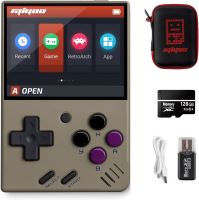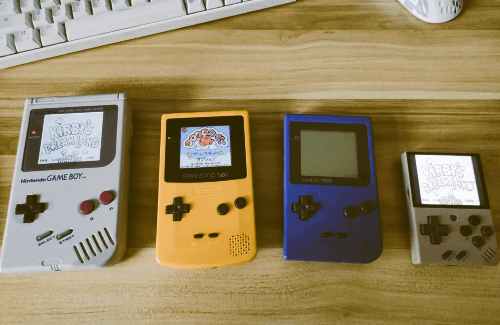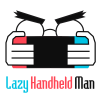It is kinda late to talk about the small retro handheld Miyoo Mini in 2023, as the device has been rolled out for nearly 3 years. My Miyoo Mini in this review is actually Miyoo Mini v2 revision, with a slightly different screen and upgraded battery. The device is a momentous device in the story of compact vertical handheld emulator, starting a wave of retro nostalgia. Once you joined the subreddit of this specific handheld, I bet you can’t resist the urge to get one. Okay, here is my trusted Miyoo Mini Review, that breakdowns why you should consider using it as your starter retro handheld emulator.
Miyoo Mini ranks B in my retro handheld emulator ranking list
Sections

The original Miyoo Mini that we loved
It is really difficult to get your hand on the smaller Miyoo Mini at the moment, as the manufacturer is targeting to supply the bigger Miyoo Mini Plus instead.
Miyoo keeps improving its iconic Miyoo Mini to version 2.0, which you should get following my affiliate link below. It is a “mini” vertical retro handheld device that can emulate anything up to gba, snes and psx.
Other Miyoo Reviews:
Miyoo Mini Review: Price
- Commonly found at: $75
- Costs 1.12 times the Anbernic RG35XX
The Miyoo Mini is normally found at $75, but usually you will get lower price from my referral links. At the moment, you can only buy the revision 2 of this retro handheld. The Miyoo Mini would cost a bit higher than the Anbernic RG35XX, and similar to the new Anbernic RG Nano.
At its price, the Miyoo Mini is supposed to do the same task as the Anbernic RG35XX, but it costs slightly higher. So considering price per performance, you would know the answer. Still, price is just one factor when choosing a starter retro handheld emulator.
For the price, I would like to recommend the Miyoo Mini Plus, which is essentially the bigger version of this Miyoo Mini, plus Wi-Fi function. However, for different taste, the original Miyoo Mini could serve better. I also guess it’s the reason why you’re reading this Miyoo Mini review.
Again, I must highlight that you should buy from Amazon if possible. There is no benefit to buy a retro handheld emulator without the classic free return, especially when you don’t make sure it is the right device for your taste. AliExpress could be cheaper, but it takes longer to deliver to you.
I still believe that my review is enough to help you get the right decision. After all, it is my hobby to say out loud, rather than maximizing my profit from referring products.
Related post: Best handheld gaming console.
Miyoo Mini Review: Design and Build Quality
| Miyoo Mini | Features |
|---|---|
| Dimensions | 65 mm x 93.5 mm x 18 mm |
| Weight | 106 grams |
| Form | Vertical |
| Screen | 2.8 inch IPS, 640 x 480, 285.71 PPI, 4:3 aspect ratio |
| Colors | White, Retro Gray, Transparent Blue, Transparent Black |
| Speaker placement | Front facing |
| Storage | External microSD |
| Audio output | 3.5mm headphone jack |
| Video output | ✗ |
| Charge port | USB-C |
- Mini form, pocketable
- Suitable for one-handed play
- Very light, about 0.74 Game Boy Advance SP
- Screen is mostly suitable for GB and GBC games, and okay for GBA games
- Screen is retro-purist, meaning NES, SNES and PSX games have good scaling
- Build quality is decent
The Miyoo Mini is truly a “mini” handheld gaming console from its specs, and if you can’t imagine the dimensions, you can copy the data and input in comparesizes.com. The device is a lot smaller than a Game Boy Color, as you can see in the picture below.

The Miyoo Mini brings out the design of the original Game Boy Pocket that we used to play in the 90s. It’s a great marketing orientation strategy to bring back the nostalgia, as retro handheld emulator’s customer segmentation is very likely one who lived in this retro era. It is so good that the Anbernic RG35XX shamelessly copy it for a bigger form, and I can’t blame that it isn’t a right thing.
There are pros and cons of this Miyoo ‘mini’ form. It is really pocketable, together with its super light weight, so you can bring it everywhere. At 106 grams, it is even lighter than my Game Boy Advance SP, and lighter is better, so one point for the design of this Miyoo Mini. Plus, it serves the purpose of being a sidekick handheld that you can play anywhere, anytime easily. Due to its portability, I see myself using it when going for gym, or when waiting in line.
However, being small means the Miyoo Mini is only suitable for one-handed gaming use. It works for some RPG titles that don’t need you to continuously spam buttons or combine movement buttons. The smaller size makes the D-Pad’s size not comfortable to my hands, and if I try an action game, I’m sure to suffer from fatigue. In fact, I must keep my gaming sessions shorter than 30 minutes to avoid fatigue, but sometimes it won’t work.
The Miyoo Mini comes with 4 different color variants: white, retro gray, transparent blue and transparent black. My unit is retro gray with maroon red buttons, that resembles the original Game Boy handheld. Actually I prefer the transparent black version, but I don’t really think that much when buying a handheld. After all, I’m on the side of enjoying games more than enjoying devices.
Because the Miyoo Mini follows the design of the famous Game Boy, it will have only mono speaker. However, because of its mini size, users will always block the speaker, thus reducing audio quality. In this case, the bigger Miyoo Mini Plus is better, and that’s why I keep it especially for starter emulators. Still, I recommend to use headphones for better audio quality.
The Miyoo Mini version 2.0 has an upgraded screen versus the first model. People believe that it has darker blacks and less hazy glass for the laminated IPS screen. In real-world use, I confess that I can’t easily tell the difference between these two versions. Yes, other screen specifications remain the same. You will get a 2.8-inch IPS screen with 285.71 PPI. As I’m familiar with IPS screens, I feel the saturation and brightness of the Miyoo Mini is similar to the baseline RG35XX.
A screen with resolution of 640 x 480 pixels is perfect for scaling most retro games, especially in console games that use CRT monitor in the past, like NES, SNES or PlayStation 1 systems. It tries to capture the same feeling of playing original Game Boy, and the aspect ratio is also okay for playing Game Boy Advance games.
Lastly, the build quality is decent for the weight and plastic material. It does feel a bit cheap, and the buttons are too soft for my liking, but overall it will last as long as you don’t abuse it. There are too many posts complaining about the Miyoo Mini’s build quality, but I just think its owner isn’t the most careful person.
Miyoo Mini Review: Gaming Experience
| Miyoo Mini | Features |
|---|---|
| CPU | SigmaStar SSD202D (Cortex-A7), 2 cores 2 threads @ 1.2 GHz |
| GPU | ✗ |
| Memory | 128 MB DDR3 |
| Battery | 2000 mAh |
| Connectivity | ✗ |
| Cooling system | ✗ |
- Good optimization for performance
- Targeted system emulator: GB, GBC and GBA
- Targeted game genres: JRPG, casual or mini games
- Battery life is very good
- Experience with Onion OS is good
Related post: Best retro handheld emulator.
Performance
- Game Boy: Popeyes 2
- Game Boy Advance: Fire Emblem: The Blazing Blade, The Legend of Zelda: The Minish Cap
- NES: Elevator Action, Gun.Smoke
- SNES: Star Fox! Starwing
- PS1: Castlevania: Symphony of the Night, Metal Slug X
 |  |  |  |  |  |  |  |  |  |  |  |  |  |  |  |  |
| 🔵 A | 🔵 A | 🔵 A | 🔵 A | 🔵 A | 🔵 A | 🟠 D | 🔴 F | 🔴 F | 🔴 F | 🔴 F | 🔴 F | 🔴 F | 🔴 F | 🔴 F | 🔴 F | 🔴 F |
The Miyoo Mini upgrades from the previous Bittboy and PocketGo models in terms of raw power. The new custom chip is a highly integrated SoC based on ARM Cortex-A7 dual core, and it handles overclocking very well, despite of not having GPU. Technically, the Miyoo Mini delivers the same performance as the Anbernic RG350 that you can’t get at the moment.
I wrote an extensive guide on What systems can Miyoo Mini emulate? You should check it out.
The SigmaStar SSD202D SoM board is currently selling at $38, so in terms of pricing, the Miyoo Mini and its brother – the Miyoo Mini Plus are well-priced. In fact, I always want a newer processor, so the Miyoo Mini is my choice instead of the RG35XX that uses a 2013 processor.
There is a 2D accelerator and the graphics pipeline allows for some scaling. In real-world use, the Miyoo Mini is perfect for emulating Game Boy Advance (gba) games, with no slow like the original PocketGo. However, running SNES or PSX games is a bit laggy, especially when trying SNES games using FX chip or 3D PS1 games. That’s very impressive for a system with no real GPU, and I must say that’s good optimization for performance.
I’m not really into SNES games personally, and my library doesn’t have the best genres for the Miyoo Mini. With its shape and size, playing Star Fox in SNES system with the Miyoo Mini is not fun, and I can’t try completing even one stage of the game. Even worse, there are a few frameskips in my whole gameplay, as this games is one of the games using special FX chip.
Playing PlayStation 1 games is a bit challenging, as the original hardware of the Sony PlayStation is much better than the Super Nintendo Entertainment System. That would be expected because the system is released nearly 5 years after. There are so many PSX games that I would love to play on handheld, and the Miyoo Mini does a good job. Not really as good as a horizontal retro handheld, like the Anbernic RG353PS, but actually it is cheaper, so I don’t complain.
And that is the limit of the Miyoo Mini. You can’t expect playing Nintendo DS or Nintendo 64 games on this device, as these games are going under 64-bit era. Not anymore, you can now play Nintendo DS on Miyoo Mini, thanks to hard works made by Steward-Fu and others. Playing PlayStation 1 games on a handheld at this price point is the most awesome thing, so don’t push the device beyond that. You should wait for its next generation. I recommend you to check this Miyoo Mini’s NDS compatibility list before trying.
Related post: Best handheld gaming PC.
Gaming session
With its vertical form and small size, the Miyoo Mini is only suitable for casual or mini games. Some JRPG titles of Game Boy Advance system are great to play, most notably the Pokemon series and/or Final Fantasy Tactics. Sadly, my time of using the Miyoo Mini is too short to complete any game, as I feel lacking something.
I mostly use the starter retro handheld emulator when I need short gaming sessions, for example when I need to wait in queue or rest 2 minutes between gym sets. I also prefer a cheap handheld that I can give to my kids, and the Miyoo Mini is the most suitable item. It is mini, so kid players like it more than, said, the Nintendo New 3DS XL (which is my favorite handheld).
Sadly, it doesn’t work with action games. If you love SNES games (which I don’t) and PSX games, depending on your hands’ size, you can’t play for long. Moreover, I really want an analog stick for playing PS1 games. I know, there is no such thing in the official PlayStation system, but after playing with the PS Vita, a left analog stick really improves gaming experience.
About the system, you can install Onion on Miyoo Mini, and experience one of the best custom systems made by the community. I wrote lots of guides in Miyoo tutorial, which is applicable to both the Miyoo Mini and its bigger brother, the Miyoo Mini Plus. If there is one reason I would like to use the emulator instead of the original hardware, it would be the convenience of the custom firmware like Onion.
There is no connectivity available on the Miyoo Mini, so you can’t connect to the Wi-Fi like the Miyoo Mini Plus. At the moment, the lack of Wi-Fi functionality limit the Miyoo Mini to be played on single-player mode only. You can’t get achievements online, too, and I know many people can’t live without achieving something.
As a player who only uses handheld devices like the Miyoo Mini for short time, I would like Bluetooth to use with my true wireless earbuds. I know that more functionality will attribute to the final weight of the product, but that is a sacrifice that I’m willing to make.
Battery life
The Miyoo Mini v2.0 is supposed to have upgraded battery from the first model, specifically from 1900 mAh to 2000 mAh. Such minor change doesn’t really affect the play time, as the Miyoo Mini will serve you well for 5-6 hours, with brightness about 5/10. To conserve battery, you should reduce volume as low as possible, as I have a record of playing 8 hours with 2D games from GBA and NES. Considering that I only use around 20 minutes each gaming session, the Miyoo Mini can last for days.
It also uses common USB type C charger port, which is common at the moment. I recommend to use a 5V 1A charger with an USB A-to-C cable, as it is better for your handheld’s battery life. Normally, it takes 3 hours and a half to fully charge the device from low battery, which is surprisingly similar to the Miyoo Mini Plus with bigger battery capacity.
My verdict
I believe that the targeted customer of the original Miyoo Mini is either someone who loves playing small devices with only one hand, or small kid. Otherwise, I only have average hands and I can’t use the Miyoo Mini for too long, so I don’t think it is suitable for playing conveniently. It is cute, but as a handheld for enjoyment, I don’t think it would be my pick.
Being a bit more expensive than the baseline RG35XX, the Miyoo Mini only does the same things as the popular device from Anbernic. I find the Miyoo Mini Plus playing PSX games a bit better than this smaller model, while using the same processor. That could be unit variation, nevertheless, it doesn’t matter because the shape of the Miyoo Mini discourages me to play action or fighting games.
What you could expect from buying the original Miyoo Mini at the moment? I think that you should expect a small handheld that you only play occasionally, and if you’re looking for a device to relive your most favorite action games, you should be disappointed. Keep that in mind and you will find the answer whether you should buy this handheld or not.
- You want a ‘mini’ and one-handed handheld
- You want a GBA, SNES and PSX handheld
- You want a smaller ‘mini’ handheld: Get the Anbernic RG-Nano
- You want a cheaper GBA handheld: Get the PowKiddy V90 or PowKiddy Q90
- You want an overall better performer at the same price: Get the Miyoo Mini Plus or Anbernic RG35XX
- You want a horizontal handheld: Get the Anbernic RG353PS
- You want a SNES or PSX handheld: Get the Miyoo Mini Plus, or better, Anbernic RG353PS
- You want to play N64 or more: At least get the Anbernic RG353M
